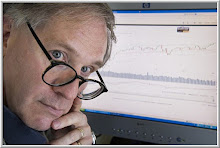
7/18/2025 - Essential to trading edges is our trade execution. There are different execution rules and strategies for different kinds of markets. Treat all markets the same and you'll get suboptimal results, become frustrated, and then blame your problems on "trading psychology". Key consideration: Is the current market trending; is it cycling; or is it cycling within a directional trend? Very often, there are short-term cycles even within strong trends that offer great risk/reward entries and effective spots to take profits. Amazing how our psychology improves once our market understanding improves--
7/17/2025 - Yesterday taught an important lesson in the market. Stories about the possible firing of the Fed Reserve Chair created sudden volatility and large price swings in the overall market. I was in the middle of a decently sized position in the stock index futures market when the news hit. The position was based upon a well-researched idea, and the idea was working out--until it stopped working out. I waited for the next bounce, took modest profits, and waited out the storm. The important lesson is that the idea is not the trade. The idea informs your position, but the management of the position involves tracking price, volume, and the here and now risk and reward. It's important to find and trade edges in the market, but that's only the first step in sustaining profitability.
7/15/2025 - In my first book, The Psychology of Trading, I described my college experience with playing pinball machines. What I found is that each machine had a particular quirk that could be exploited to consistently score points. For example, on one machine, if you let the ball come down the chute and hit the left flipper (without using the flipper), the ball would bounce to the right flipper, where it could be sent back through the chute for points. Rinse and repeat. I consistently won free games exploiting this quirk and I quickly learned to experiment and find quirks on other machines.
The stock market is not a pinball machine. It is a collection of different machines. The quirks of one stock or one type of market differ from others. The key is to be willing to experiment and experiment and lose and lose until you figure out the quirk/edge of the current type of market. Very often, as with the pinball machine, the quirk comes from a non-obvious way of playing the game--and consistently exploiting that edge. Success comes from doing something unique very well and very consistently. As in poker, the need to keep playing the game under all conditions eliminates all edge.
7/13/2025 - Traders are typically looking for probabilistic edges in the markets and instruments they trade. They look to put the odds in their favor. One of the greatest mistakes beginning traders make is to assume that an edge can be derived from a single source: a chart or indicator pattern, an earnings release, a breaking news event, etc. This fails to identify--and understand--the context in which the opportunity is occurring. Here are some of the most powerful edges I have encountered with the traders I've worked with:
* A move occurs across multiple time frames, as in the case of a short-term breakout that is also a breakout on a longer-term basis or a failure of overbought conditions across time periods. The broad context of the shorter-term move often defines the opportunity of that move. When time frames line up, meaningful movements often occur;
* A move occurs multidimensionally. Some of my charts have time on the X-axis; others feature bars that represent fixed units of volume. The most promising opportunities show up across the different charts as well as across time frames. For instance, the moving average crossovers that I track via Ehlers' adaptive moving average measure sometimes occur on the volume-based charts as well as the time-based charts, capturing shifts in momentum in a multidimensional fashion. I have found these opportunities to be especially promising. Similarly, simultaneous signals from multiple indicators/systems tracking opportunities in different ways are worthy of attention.
* A move occurs across related markets. If a move can be detected across the broad range of sector ETFs, there's a good chance that this represents a momentum move of the entire market and broad based participation of institutions. Similarly, if a move is occurring across such asset classes as stocks, bonds, and the dollar, the odds are good that something is occurring across macro markets that is attracting the interest of large investors. Such broad-based participation often signals an evolving trend.
What this means in terms of trading psychology is that one must be focused on many time frames and many markets and charts to identify the most promising opportunities. The great enemy of performance in this dynamic situation is distractibility. It's the ability to see many patterns across many time frames and instruments that enables the trader to capture the best opportunities. This is why it is vital to work on our capacity for focus when markets become busy. It is also why traders often perform best in team settings, where there are multiple sets of eyes on multiple markets and time frames.
Opportunity occurs as patterns of patterns.
.








